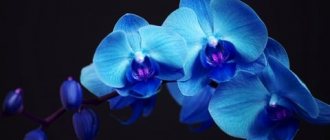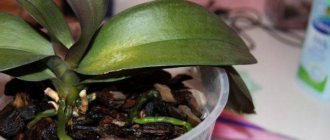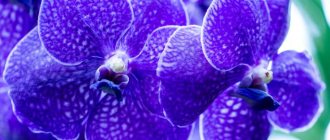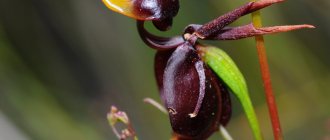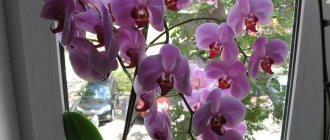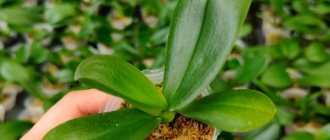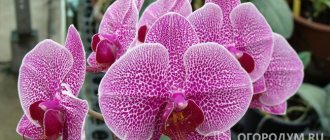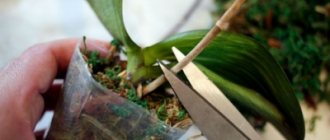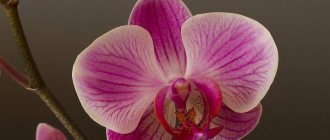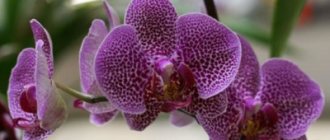0
An orchid is a plant that every gardener wants to buy. And getting an interesting specimen into your collection is doubly honorable. Not so long ago, the plant appeared on store shelves, but did not have a special assortment. One day the shelves were full of bright colorful flowerpots with flower stalks in blue and blue shades. The delight of phalaenopsis admirers knew no bounds. But is the flower of such a specific shade real?
The history of the blue orchid
Blue orchids were first presented in 2011, at an exhibition in Florida, by an agricultural company called Silver Vase. After 3 months, one of the participating firms demonstrated its version of the blue flower. After this event, all flower shops began to offer applications for the sale of blue or blue orchids. The Geest Orchideeën company, which was the second to show a blue flower, did not hide the fact that the color was obtained chemically and in subsequent blooms the orchids will be their natural color. The technique used by the representatives has not been disclosed to date, but experienced flower growers have found their own techniques.
Interesting! There is only one conclusion in this situation, the deep blue color of the orchid is not a feature of the variety, but only a desire to attract attention, which is achieved by coloring. In Western countries, such flowers are often used to decorate rooms for celebrations.
Varieties
For many years, unscrupulous sellers have been selling tinted orchids. Unfortunately, it was possible to find out this only after the first watering, when the ink was washed away by water. Such methods often lead to the death of flowers from intoxication, and in rare cases when the new pet still survives, the flowers are no longer pleasingly blue.
Modern breeders have bred blue orchids. Hybrids belong to different families, such as Vandas, Cattleyas, Phalaenopsis.
For those who do not have much experience in growing orchids, blue Phalaenopsis is perfect. These hybrids are created for indoor conditions and are unpretentious in care (
Varieties with a blue tint
Despite the fact that deep blue orchids have not yet appeared in nature, there are still species that slightly correspond to this color scheme:
- The Vanda orchid is a variety to highlight. In nature, it can be found in the forests of China or Thailand. Vanda's purple or lilac flowers are covered with white spots. The variety is not very suitable for growing at home because it needs special care. But Vanda has the ability to cross well with other varieties of orchids, which many breeders use for their own purposes. The result is species of orchids with varying intensities of purple color.
- Cattleya is another orchid that is not as demanding of care as Vanda. During flowering, this variety has a very delicate aroma, but also does not have a rich blue or light blue color. Sometimes in stores you can find purple or pink-blue Cattleya.
- Phalaenopsis is the most unpretentious variety of orchids that can most often be found at home. In addition, this particular variety is sold in blue in stores. Phalaenopsis takes root well in homes where there are people with allergies; this plant does not have cloying odors and does not emit pollen.
Attention! All of the above species do not have the blue color we are talking about and in the most ideal version they can only have a bluish tint.
Features of cultivation in the regions
As we have already mentioned, the Uslada apple tree primarily lives in the European part of Russia.
In general, this variety is quite unpretentious and hardy, so even novice gardeners can grow such a tree.
To avoid problems when growing in regions, it is important to take into account some features of the Uslada variety. Uslada has adapted well to this region, despite the high rainfall and few sunny, warm days in the summer, thanks to its good scab resistance
Uslada has adapted well to this region, despite the high rainfall and few sunny, warm days in the summer, thanks to its good resistance to scab.
Moscow region
The conditions in this region are suitable for growing the Uslada variety. It bears fruit well in fertile soils, and its viability helps it adapt to local weather conditions.
Siberia
Although the variety is winter-hardy, the dwarf frost-resistant Uslada apple tree is well suited for growing in the harsh conditions of Siberia.
Siberian region.
How can you tell if an orchid is colored?
Whether an orchid is painted or not is quite easy to understand if you pay attention to a number of signs:
- the stem of a normal orchid is of natural color, without the shades inherent in the flower;
- if a colored mark remains on the skin after touching a flower, it means that orchid paint has been applied to it;
- the soil in which the plant grows should also not show signs of coloring, its color is completely natural.
Important! If you are lucky enough to buy a blue orchid, you should know that the initial care for it is slightly different, because the plant was subject to chemical and mechanical intervention.
How to get blue orchid flowers?
There are two ways that help give blue tones to a white flower. The most humane of them is coloring through water that is watered on the plant. This method has the disadvantage that when watering stops, the flower returns to its natural color. In addition, the stem of the orchid also becomes somewhat blue during watering. To obtain the desired effect, it is enough to dissolve the dye in water in the required concentration; the more dye, the richer the color of the flowers.
Important! It should be remembered that the use of dyes is harmful to the plant.
A blue orchid at home can be obtained after coloring injections. The injection is usually given in the area of the peduncle; it should be carried out as least traumatically as possible. You need to take a syringe with the thinnest needle and fill it with liquid with dye.
For mixing, it is better to take warm, settled water, and the injection site and the needle itself must be disinfected. If there is no opportunity or desire to buy chemical coloring preparations that are available in flower shops, you can use food coloring.
Important! It is better to carry out coloring injections by piercing the peduncle; introducing the drug into the roots is the most traumatic for the orchid.
It is necessary to understand that any of the methods is potentially dangerous for the orchid and can lead to diseases and even death of the plant. After applying the coloring material, the flower needs additional care.
Distinctive features
“Singolo, the first monochromatic orchid, is a striking species,” says Dutch phalaenopsis specialist Opti-flor. The company demonstrated this new product at the international trade fair IPM 2014 in Essen, Germany.
“It is unique in its kind, preceded by a long-term selection and hybridization process in Opti-flors.” The result is described as a compact plant with one beautiful large white flower. Due to its small size, the plant requires only a small amount of space in the house.
Although the orchid is exclusively a white phalaenopsis, the company also displays the pink "Singolo" variety. Many experienced orchidists do not agree that this is a truly created hybrid. They note that manufacturers are misleading consumers.
With many of the plants sold, you can clearly see that the flower stem is cut to make just one large flower. An opinion has been expressed about the use of “compressive” retardants.
Further actions
If you bought a painted orchid at a flower shop, you should not rush to replant it. Depending on how long ago the procedure was carried out, the flower needs a period of rest and the opportunity to adapt to new conditions.
If you notice a deterioration in the condition of the orchid after purchase, you need to take some measures:
- Carefully remove the plant from the pot and rinse the roots under running water.
- Trying to find traces of injections, if they are found in the root area, it will be difficult to save the orchid.
- Usually the place where the injection was made forms rot; it is advisable to cut off this place and apply crushed coal or ash.
- After inspection, transplant the orchid into new soil, which consists of moss and bark.
- In the future, if the orchid begins to recover, care for it is standard, intended for the variety.
Transfer
The orchid must be replanted as the bark grows or breaks down in the substrate. This usually happens no more than once every 2–3 years. Transplantation is best done in the spring, at this moment the plant’s vitality is at its peak and the plant tolerates all procedures painlessly.
For planting it is necessary to use transparent flowerpots and specialized soil. Planting orchids in ordinary light-proof pots is unacceptable. Photosynthesis processes take place in its roots. During transplantation, the root system is thoroughly cleaned of the remnants of the old substrate, and all rotten and dead areas are removed. To process the resulting sections, use cinnamon powder or charcoal.
During the first 2 days after transplantation, the plant is not watered, then watering is gradually resumed. To speed up rooting, you can add a couple of drops of Zircon to the irrigation water. It effectively relieves stress and accelerates growth processes.
Lighting
Lighting conditions are very important for any type of orchid. If the pot with the plant is placed on the west side, you can practically eliminate the need for artificial lighting.
The western side of the window prevents direct sunlight from entering the flower.
It is also possible to place an orchid on the south side of the apartment all year round, but on hot days it is necessary to control the soil moisture and add water if necessary. The location of the orchid pot on the windowsill on the north side requires the installation of additional phyto lamps, which will extend the daylight hours.
The orchid blooms best if it is illuminated for 12-16 hours.
Interesting! If there are no purple pigment spots on the inside of the leaf, this indicates that the orchid does not have enough lighting.
Despite its light-loving nature, the sun can be dangerous for orchids during its active period; at this time it is better to hide the plant in the shade. If it is not possible to extend the daylight hours for an orchid, cut it off for the winter and leave it until the lighting increases naturally.
Watering and fertilizing
The watering regime should be adjusted independently, based on the ambient temperature; the faster the moisture evaporates from the pot, the more often it is necessary to add water. In any situation, the humidity level must not be exceeded, as this can cause rotting of the root system.
For many gardeners, the immersion method is convenient, in which the pot along with the plant is lowered into a container filled with water for 30-60 minutes. After the pot is cured, excess moisture is drained through the drainage holes.
If you use watering in the form of bathing the orchid, you need to do this under a weak water set or use a shower. Then let the water drain and remove moisture from the axils of the leaves.
Due to the unusually bright colors, it becomes clear why the blue orchid is so popular. Before you decide to carry out the coloring procedure at home, you should understand that interfering with the natural course of an orchid’s life can be detrimental to its health.
